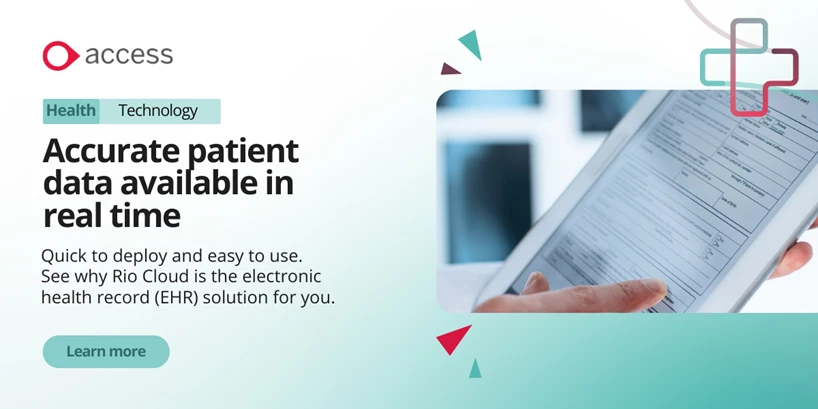Collaborative Working in the NHS - Your Guide
Collaborative working in the NHS puts partnerships between clinicians and organisations at its foundation. We see this in action through patient engagement and the patient experience, both of which are priorities under the NHS Long Term Plan and the NHS’ Integrated Care protocols.
These partnerships are being pursued by the NHS – primarily through NHS England, due to devolution – with the goal of taking that difficult first step of making contact with other health and care organisations. Establishing regular communication channels and building connections takes time, something healthcare professionals don’t have a lot of, so they need incentive – or a nudge in the right direction in this case.
There are benefits to be gained though through greater communication though; better knowledge of treatment methods, of population trends, of patient needs… the list goes on. In this article we’ll guide you through what collaborative working entails. We’ll touch upon NHS Trusts in England (NHS health boards in Wales), though that topic is for a companion blog to this piece given how much there is to talk about on collaboration between trusts. Instead, this is a guide to explore what collaboration needs to succeed, and what you as a healthcare provider can do – whether inside the NHS or outside – to be engaging and cooperative.

Collaborative working NHS
Collaborative working and the NHS: as an operating protocol it seems obvious that hospitals and trusts or health boards would need to work in tandem regularly, but in reality collaboration has been overlooked for most of the NHS’ existence. First though, lets explain what is meant by ‘collaborative working’:
What is collaborative working NHS?
The World Health Organisation describes collaborative working in healthcare as “when multiple health workers from different professional backgrounds work together with patients, families, carers and communities to deliver the highest quality of care across settings."
Within the NHS setting, this refers to active collaboration and partnership across the care continuum; providing joined-up care between primary, secondary and community care.
In more recent times we’re seen the introduction of Primary Care Trusts (PCTs), which were replaced with Clinical Commissioning Groups (CCGs), and since summer 2022 we’ve replaced these again with Integrated Care Boards (ICBs).
The name of the game is collaboration now though. The NHS is eagerly pursuing a joined-up care approach to healthcare in modern-day Britain. This requires a digital overhaul (the NHS Long Term Plan) and through that frontline digitisation (guided by the Digital Capabilities Framework).
It’s not just about throwing software into the mix though. People need to take action too. Communication was flagged as a major issue in NHS surveys, hence the big push on software, but it’s more than that. Healthcare professionals aren’t talking to each other enough. In the same hospital or clinic, sure. People regularly interact. Beyond that? We need clinicians talking across a wider distance; trading information and insight, discussing potential problems and solutions.
This is why Integrated Care Boards were introduced to overhaul CCGs. There needed to be more focus on collaboration, cooperation, and communication. By forging a collaborative setting in the ICB, different organisations can have a seat at the top table to discuss the major pressing issues, but also there’s greater impetus for all professionals to engage with sister departments and other teams. The Integrated Care Systems (ICS) that the ICB oversees are that collaboration in action; an umbrella of different healthcare organisations working in tandem to cover care provision across the care continuum and provide holistic care of a consistently high quality.

How are healthcare organisations working together?
The most common instances of collaboration come through NHS Trusts in England and NHS health boards elsewhere, but there’s so much to talk about we’ve opted to write an accompanying blog (NHS collaborate - Top tips for Trusts) so that you aren’t swamped with information!
Trusts aren’t the only ones collaborating in or with the NHS though, as you might have guessed, so we’ve got some examples of collaboration and cooperation below.
Provider Collaborative
King’s Fund defines provider collaboratives as “are partnerships that bring together two or more NHS trusts (public providers of NHS services including hospitals and mental health services) to work together at scale to benefit their populations.”
Since July 2022, NHS trusts that provide acute and/or mental health services have been mandated to be part of a provider collaborative. The formal move is to force collaboration and partnerships, so that organisations can work together to improve care quality. It sounds odd to suggest the NHS is forcing action from the top down, but the post-pandemic landscape is difficult.
The assessment from the NHS is that no organisation can resolve the issues caused by backlog and Covid’s continued existence without teaming up. This collaboration can help with operational efficiency (especially staffing), with the consolidation of certain services, and with limited finances; the logic being that multiple hospitals or even trusts operating in conjunction could generate greater purchasing power and thus use increased volume to drive costs down.
The NHS states that there will be opportunities for community services, independents, and the VCSE sector to join these collaborations going forward – in circumstances where it is beneficial.
Interoperability Data Design Collaborative (IDD)
The Interoperability Data Design Collaborative or IDD is a collaboration project which started Late 2019. It is made up of health and care professionals meet to discuss data interoperability. This is more important than it might sound at first, because data accuracy and data sharing are the foundation of all activity within the NHS. Poor information can and does lead to harm, and good clinicians are aware of this. A lack of confidence in data quality would mean clinicians avoid taking action. That would bring the NHS machine to a halt, so interoperability (typically via APIs) allows different software solutions to communicate. The IDD meets to discuss how that’s going, good solutions, bad solutions, as well as potential areas of improvement, development or opportunity.
Joint Working
Collaborative working is the term we use for partnerships that benefit patient care or the NHS. Joint working is a specific form of collaborative work that applies in cases involving pharmacies and their partnerships with the NHS, according to the Association of the British Pharmaceutical Industry (ABPI). Their toolkit on collaborative working and joint working states that joint working is permitted in “Situations where, for the benefit of patients, one or more pharmaceutical companies and the NHS pool skills, experience and / or resources for the joint development and implementation of patient centred projects and share a commitment to successful delivery.”
There is an additional caveat in the guide that collaboration “must be patient centred and always benefit patients directly, which gives it a narrower focus than collaborative working.”
NHS Wales Health Collaborative
NHS Wales is a devolved instance of the national health service, as are the provisions in Scotland and Northern Ireland respectively. As such, they often share many of the same principles and operational strategies, though there are regularly differences in approach or delivery.
NHS Wales established this health collaborative back in 2015 to work in conjunction across their health boards, given the size of the nation and the relatively modest population. This allowed them to leverage the purchasing power and volume benefits mentioned earlier.
Care collaboration
Since the enacting of the Care Act 2014, local authorities and care partners are legally obliged to collaborate to deliver care to members of the community. The local authority is the lead on safeguarding, but the care agency is expected to have a designated safeguarding officer and there are additional expectations set out in the act regarding the treatment of clients and the importance of respecting their wishes whilst meeting their care needs.
For more information on this topic you can visit the Leicester Safeguarding Board website.

Challenges facing collaborative working
There are three primary issues that can – and likely will – impact collaborative working:
- Perceived Risk
- Common Practice
- Interoperability of Software
Starting with risk, the concerns typically surround pay. The perception is one of uncertainty about whether pay rates will be consistent and the payroll will be reliable. This is an issue of governance, regarding who has the ultimate say on a matter, and the subsequent accountability about who – if anyone – is acting enforcer.
Accountability and governance tie into the issue of standardised culture, as different hospitals (let alone trusts) will have different operational styles. People can be wary of change, and even resistant to it, so there needs to be enforcement to ensure partnered groups line up behaviourally.
The final issue is interoperability – something we at Access know all about. Our customer experience regularly has us told how software propositions aren’t interoperable, which is why we’re very strong on being a best-in-class or best-of-breed solution provider that is happy to fit our software into existing ecosystems. The sad reality is that IT investment in the NHS has, until the last few years, lacked direction or coordination. Hospitals did their own thing and sometimes that worked, sometimes it didn’t. The NHS’ long term plan is part of the remedy to this past lack of cohesion, and NHS digital is providing accreditation to software providers who can demonstrate a high level of competency and interoperability with their solutions.
The Care Quality Commission in its ‘Better Care Through Collaboration’ report pointed out that it perceived barriers to collaboration courtesy of things such as multiple requests for information coming from multiple sources, a lack of a centralised record when making decisions, and a lack of communication – particularly between primary and secondary care.
These issues will be solved in time with the ongoing frontline digitisation in the NHS however, but it’s worth noting that this only applies to NHS trusts and in-house organisations, not to external partners. It’s on private or VCSE (voluntary, community or social enterprise) organisations themselves to onboard suitable healthcare software that can enable collaboration with the NHS. As mentioned in a previous article about finding the ideal Healthcare CRM solution, the NHS has a reputation for being dismissive of outside partners if they don’t meet their expected standards or are incapable of integrating with their systems. It’s harsh but an easily remedied issue, and one that could get more organisations into these partnerships.

How to make collaboration successful
So, how do healthcare organisations make collaborative working a success? This is the challenge, given the differences in work culture we mentioned earlier, varying sizes of organisation and staff levels, different funding, different daily operations… some organisations will inevitably feel like they’re putting more into a relationship so there’s an inherent risk of feeling like others are slacking or uninterested, which could undo engagement.
Integrated Clinical Leadership
For any collaboration to succeed you need coordinated decision making and strategy. This requires a properly established integrated clinical leadership team, but setting that up is a challenge itself.
A variety of roles and experience need to be present to make any leadership team successful, and for the NHS – or even broader healthcare – this is pivotal because they are the ones enacting the coordinated strategy and making the big decisions. In the words of NHS Professionals: “Ideally, each provider should be represented by a senior member of staff, deputy director or above to ensure that a common understanding is reached, with the full backing of their executive team.”
Strong leadership will keep collaboration going. There’s hesitancy in workforce collaboration because there’s a lack of time and understanding and it’s change, and people often don’t like change. A firm stance from those above will sway those below into acting for the better.
Leadership can be encouraged too. Some people are confident speakers and happy to dictate to others, but these skills can be developed from the ‘grassroots’ level so to speak. All levels of clinical duty can be supported and encouraged and trained on what makes for good leadership, and what skills they need to hone to be better placed to instruct others and take charge. A failure to provide this ongoing guidance is a big flaw in collaboration, as leaders are scarce – like drummers or goalkeepers. We need them, but with a little effort we can create a pathway.
Best-in-class Software
In our humble opinion as a software provider, having the right healthcare solutions makes everything that bit easier. Good software can integrate, it’s interoperable, it supports better communication, better data, and optimises existing processes to improve efficiency – and hopefully unburden staff too.
Collaboration needs time and engagement. Healthcare professionals are more burdened with demand and stress than ever before so by alleviating some of that burden through automated processes, we can free them up to do more. This might be more clinical duties, but it can also be things like more education or training, or in this case the time to communicate and collaborate.
Burnout is a big problem within the NHS and private healthcare organisations as a result of how much pressure there is currently. Assisting staff reduces the rate of burnout, which increases staff retention, but the improvement to staff satisfaction will also reduce the rates of moonlighting through agencies to work at other Trusts. Instead, staff will be more comfortable working extra/cover shifts for their own Trust, which is also a cost reduction for the Trust versus agency hire rates.
Intelligence
All of the above comes back to intelligence. Intelligent people in the right positions, intelligent software solutions facilitating communication and data gathering to enact collaboration.
With better intelligence comes better planning, organisation, and the avoidance of duplicated efforts on the same goals. Sometimes this can be with projects, but other times it can be with deals – whether that’s purchasing equipment or perhaps hiring agency staff. It’s no secret that some agencies hold out on staffing until they’re offered higher rates per hour. This isn’t good for the NHS, so collaboration here can avoid being strongarmed by agencies and achieve best value.
This brings us to the end of our guide to collaborative working. Joined-up care or integrated care, however you describe it it’s all about working together. Teams pooling their efforts and expertise to achieve a greater good for the health of their local population that alone they simply couldn’t.
We hope this article been insightful, but don’t forget to check out our blogs on collaboration with NHS Trusts and on provider collaboratives. This is a rich subject area and there’s a lot of information – too much for one sitting.




